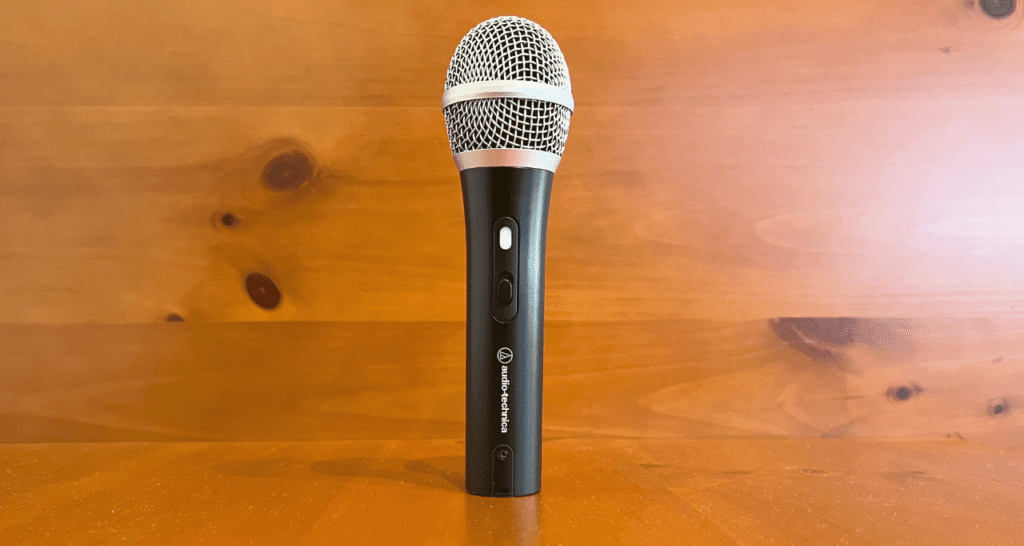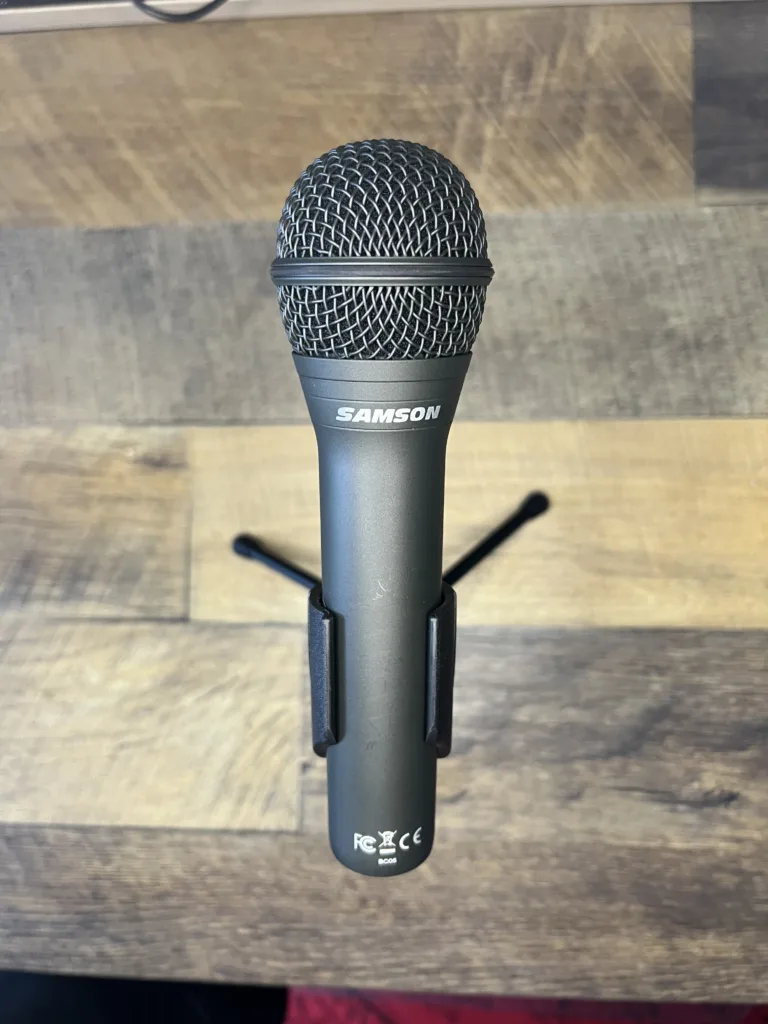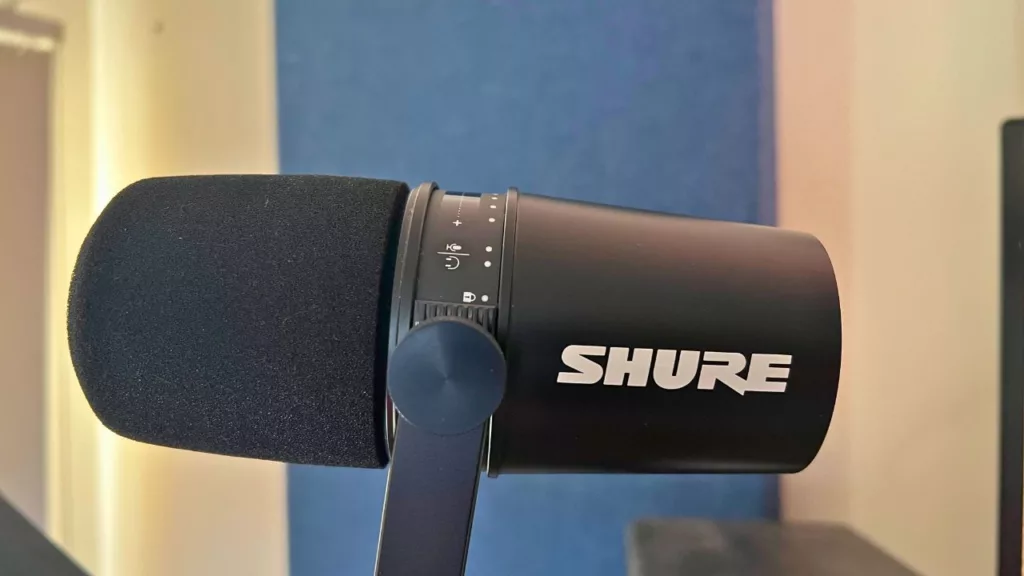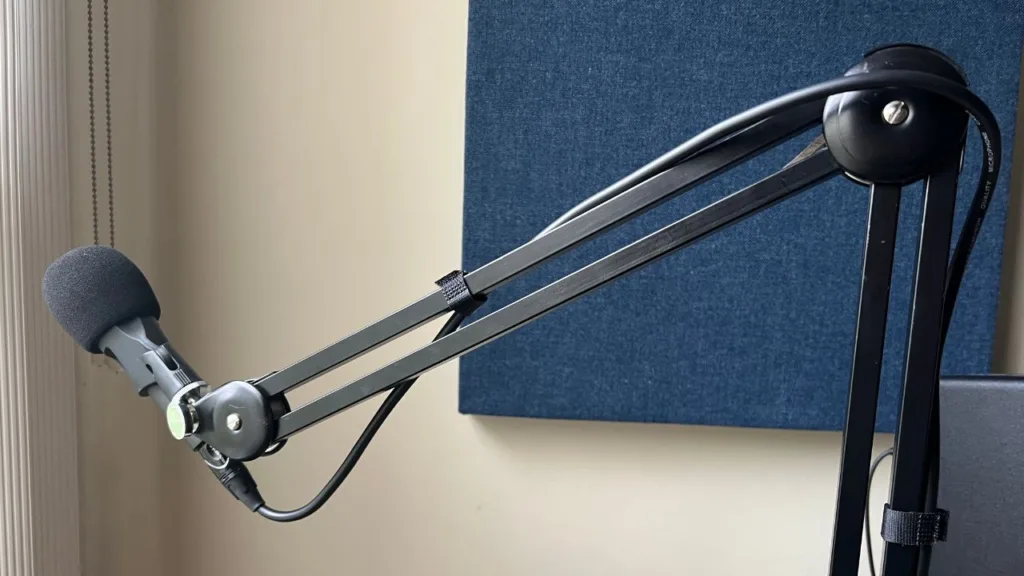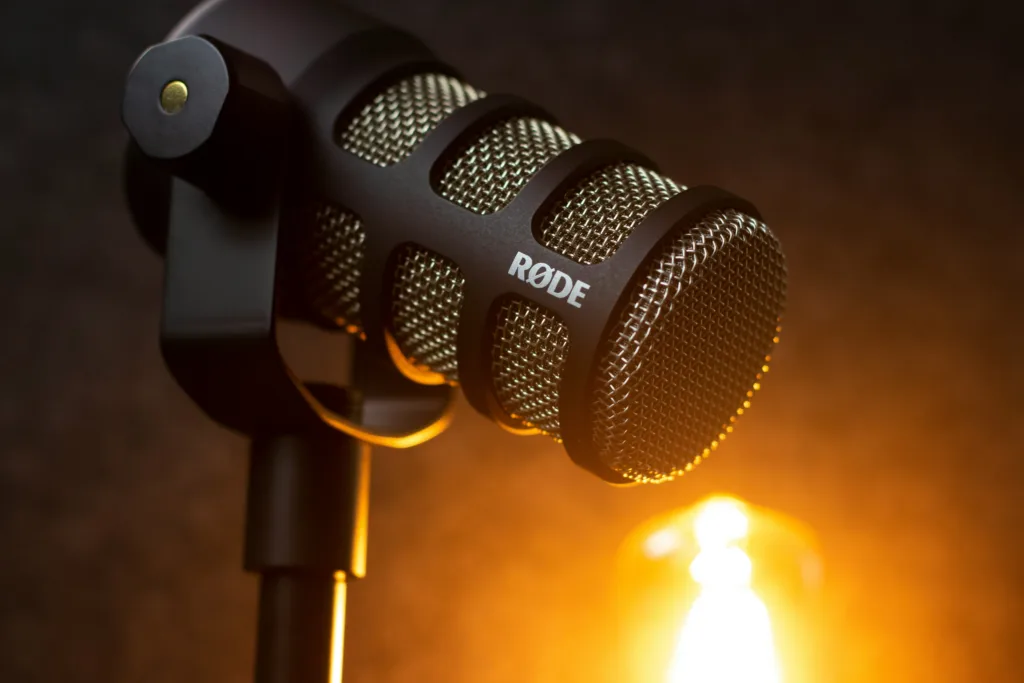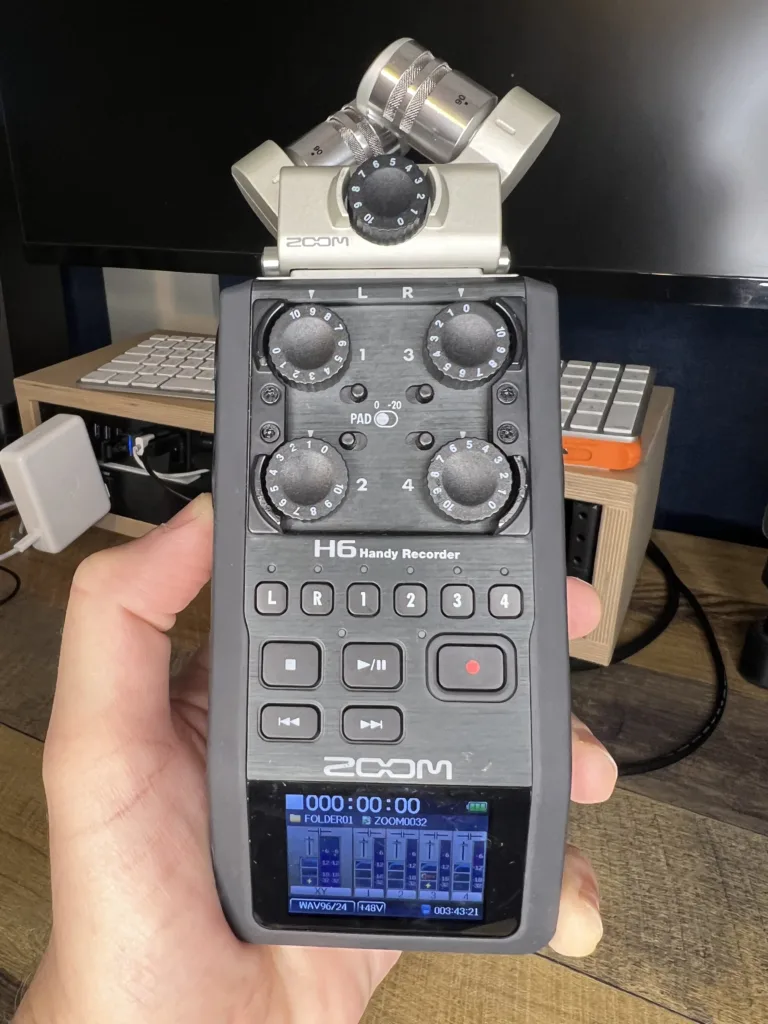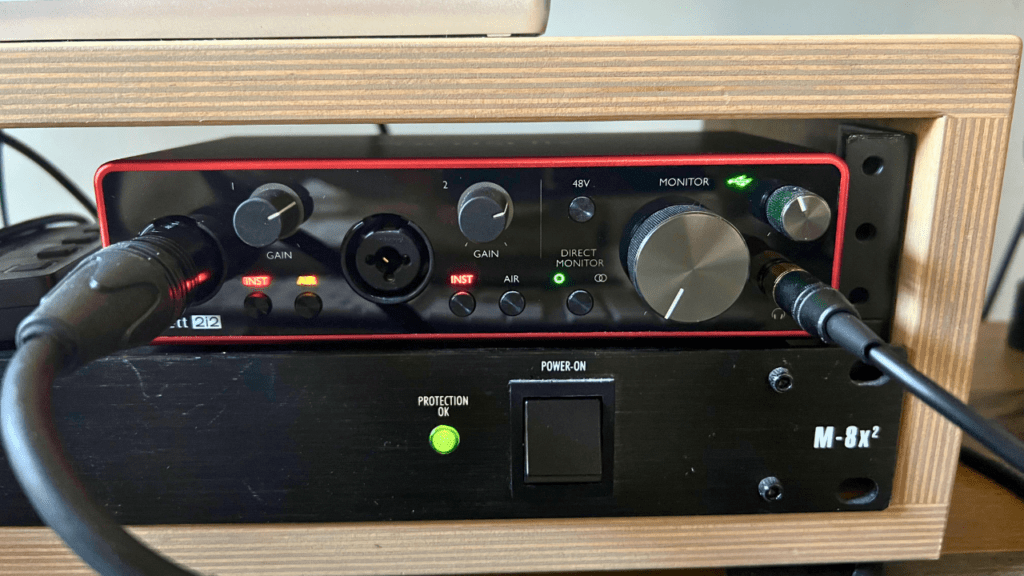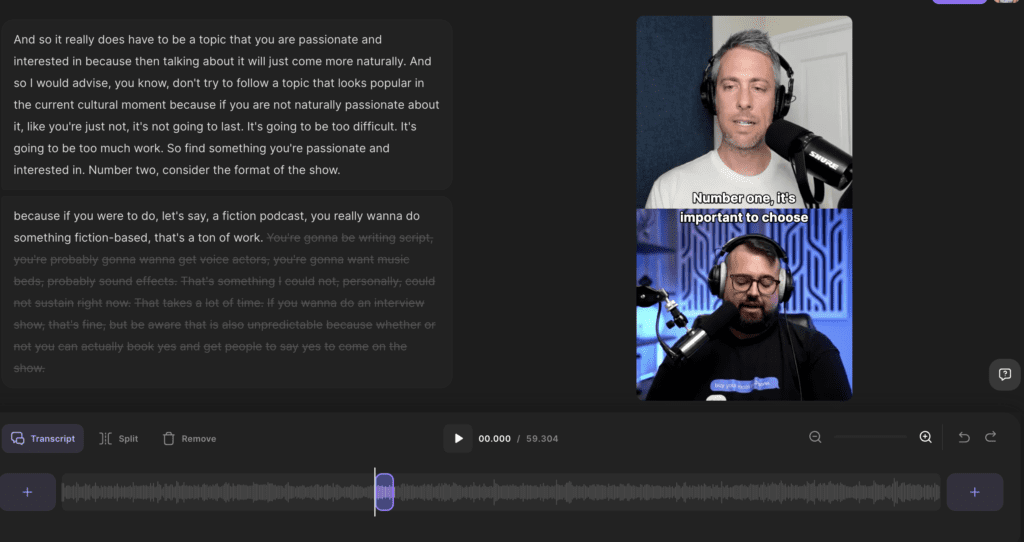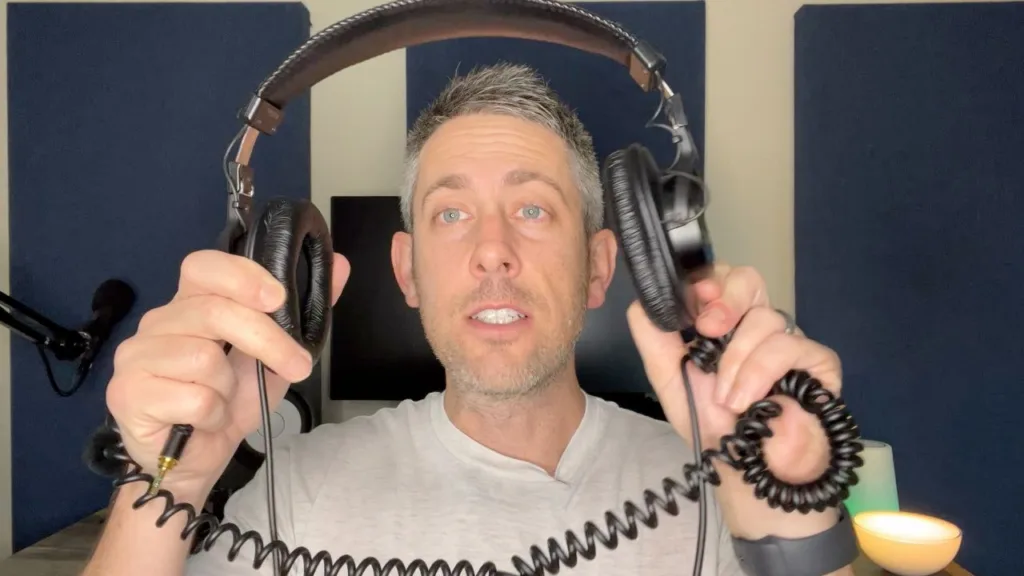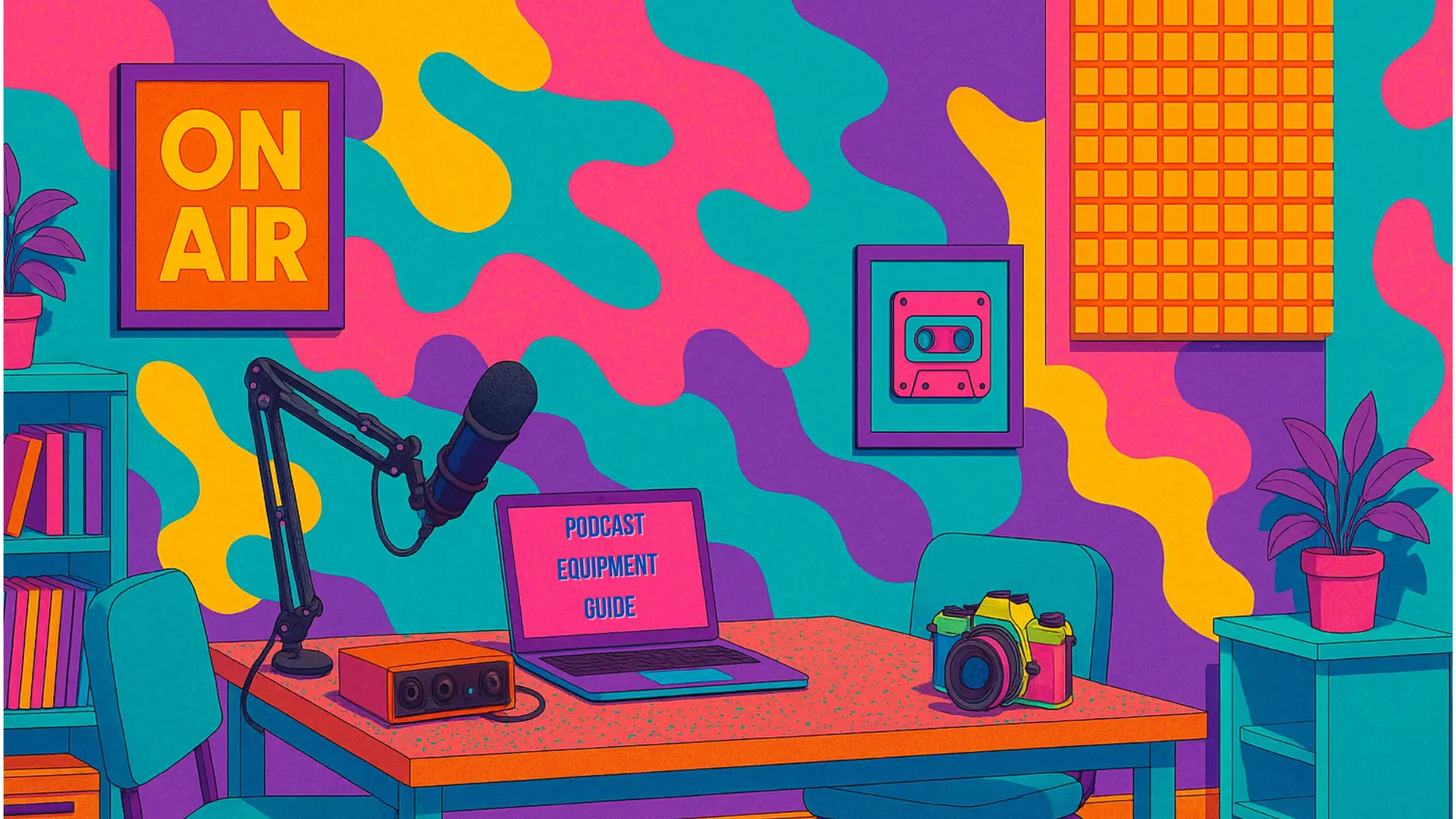
Looking for a podcast equipment guide that actually helps you figure out what to buy?
You’re not alone.
It’s easy to fall down a rabbit hole with all the gear out there—microphones, mixers, interfaces, headphones—so where do you even start?
Well, that depends on your setup and experience level. There’s affordable gear perfect for beginners, high-end options for seasoned pros, and a lot of great-sounding equipment that sits right in the middle.
I don’t want you second-guessing every purchase. That’s why I put together this podcast equipment guide for all types of creators—whether you’re just getting started or you’ve been podcasting for years.
How to Use This Podcast Equipment Guide
- How tech savvy am I?
- How much effort do I want to put into podcasting?
- What’s my budget?
- How many people do I plan to record at once?
- Where do I plan on recording?
- How much editing do I plan on doing?
Think about your answers to these questions while you read along. It’ll help you narrow down your “equipment needs” vs. your “equipment wants”.
This will be different for everyone.
To kick things off, I’m starting with the best podcast microphones. Microphones are the holy grail of podcast equipment.
🎯 Not Sure What Gear You Need?
Before you start building your setup, check out our Podcast Equipment Finder—a free tool that gives you personalized gear recommendations based on your needs, experience, and budget.
It only takes a minute and can save you hours of research.
Try the Podcast Equipment Finder directly.
Let’s Start with Microphones
You’re gonna need an actual microphone. You already knew that, but, I had to mention it because I don’t want you speaking into your computer’s built-in microphone.
You’re better than that, and if you want to build an audience, they’re going to expect better.
Additionally, if you’re thinking about buying the Blue Yeti, DON’T. If you already did, throw it in the trash or donate it. It’s a terrible microphone for podcasting.
To learn more about microphones, check out our article on dynamic, condenser and ribbon mics.
USB Microphones
A USB microphone connects to your computer via a USB port. These microphones tend to be on the cheaper side, and are more geared toward beginner to intermediate podcasters.
Pro podcasters also use them as backup mics or travel mics.
This is because they’re compact and super easy to use.
Although these microphones are cheap, as far as microphones go, they don’t sound half bad.
 The Audio – Technica ATR2100x USB
The Audio – Technica ATR2100x USB
This mic sounds pretty damn good, especially for the price point.
It’s USB and XLR, which is great if you need the flexibility of both connections, or If you plan to upgrade to an audio interface in the future.
Samson Q2u
Great sound for great value. The Q2u is USB and XLR too. This microphone captures the sound thats coming from right in front of the microphone capsule, thus rejecting room tone and ambient noise.
It has a built-in headphone jack for real-time, low latency monitoring.
Shure MV7
For podcasters looking to level up, there’s the Shure MV7. This is Shure’s answer to the USB mic game.
This microphone is younger brother of the Shure SM7B. It’s USB and XLR compatible, has a touch panel for gain, headphone level, and muting, It boasts natural vocal replication.
If you want to get fancy, you can use this microphone with the ShurePlus MOTIV desktop app, to add some vocal processing to your voice.
Rode PodMic USB
The Podmic USB By Rode is another favorite by podcasters. It is a dynamic microphone priced at $199, designed for podcasting, streaming, and more.
It offers dual XLR and USB outputs for versatile connectivity, along with high-quality sound features like a neodymium capsule and APHEX digital signal processing.
XLR Microphones
Podcasters who are more serious about their sound will want an XLR microphone. They’re built with 3 pin connectors, so they can’t connect directly into a computer, like USB microphones.
In terms of podcasting, XLR mics connect to digital recorders or audio interfaces.
These types of microphones produce higher quality audio.

 Shure SM58
Shure SM58
Heard round the world, the SM58 is iconic. In fact, it’s I’ve used 58’s since I was a teenager.
It’s more or the less the industry standard for live vocal performance. It captures an accurate depiction of your voice, and it’s built like a tank.
Rode PodMic
Contributing crisp, rich tone, to podcasters around the globe, the Rode PodMic has quickly become a favorite in the scene. The PodMic has a booming low end, internal shock mount, and is lightweight and compact.
Who doesn’t love its gold grille?
This is a badass mic that will produce crisp vocals. It’s a prefect piece of equipment for podcasters of all levels.
It was designed to pair with the Rodecaster Pro, but will sound great with any audio interface or recorder.
Shure SM7B
I imagine you’ve seen this microphone in YouTube videos. It seems like every podcaster is using this thing. For good reason too. This is a fantastic microphone for podcasters.
With it, you can get warm, in your face vocals, every time you plug this baby in.
Electro-Voice RE20
Quite possibly the most famous broadcasting microphone ever built. The Electro-Voice RE20 delivers a classic, natural sound. It’s designed for close proximity vocals and certainly packs a punch.
Podcast Recording Equipment
So, you’ve got a microphone, now how the hell do you record with it? You’re obviously going to need to plug it in somewhere and hit a record button.
There are several ways to record podcasts, but, for the sake of this article, I’m outlining what I believe to be the best three ways.
- Recording into a digital recorder
- Recording into a DAW, via an Audio Interface
- Using a web platform to record, such as Riverside.fm – Use Promo Code CLIPPED for 20% off
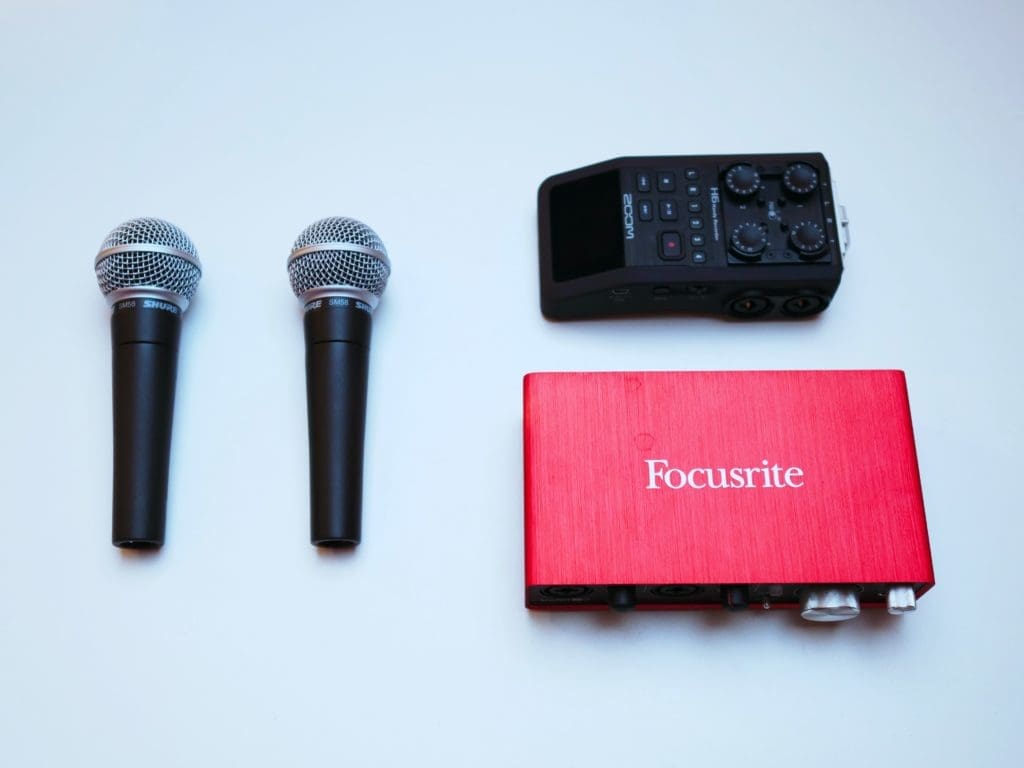
Photo By: James McKinven from Unsplash
Digital Recorders
If you’re a “hands on” type of person a digital recorder could be a great option for you. Or, maybe you spend all day at your 9-5 job working on a computer, and when it comes time to record your podcast you want to be as far away from a computer as possible.
Perhaps you travel a lot and you want to record on the go.
If you can relate to any of these situations, recording your podcast via a digital recorder could be the best option for you.
There are several digital recorders on the market that sound great and have everything you need to create a professional sounding podcast.
These recorders have XLR inputs, SD card storage, headphone jacks, and are capable of multi track recording.
Zoom H6
I’ve owned a ZoomH6 for several years. This thing produces low noise, high quality recordings. It’s got four microphone inputs, and a detachable stereo microphone connected to the top of it.
The H6’s preamps are quiet enough to crank those gain hungry dynamic microphones without inducing noise.
There’s SD card storage, various recording options, and a great looking LCD screen to monitor levels. Oh, and we wrote an in depth article on why the Zoom H6 is the ultimate portable podcast recorder.
Make sure you check that out.
Zoom PodTrak P4
The P4 has four awesome sounding microphone inputs. But, what really makes this recorder shine is the four headphone outputs, the programmable sound pads (for using SFX or music drops on the fly), it’s ability to record phone calls, and that it double as an audio interface.
Tascam Portacapture X8
At the time of writing this, the Portacapture is a fairly new digital recorder. I personally haven’t used this bad boy, but, it’s got great podcasting specs
The Portacapture has everything you need to record a multi-person podcast anywhere you want.
Audio Interfaces
For the sake of podcasting, an audio interface is a piece of equipment that enables podcasters to connect XLR microphones to their computers.
The audio interface then converts the microphones signal, which is analog, into a digital signal that the computer can take in.
Audio interfaces can have a single microphone input, or dozens of microphone inputs. Headphones and speakers can also be connected to an audio interface, as well as other types of audio equipment.
In addition to the article, here are some other audio interfaces that are great for podcasting.
Digital Audio Workstations
Software for recording, editing and mixing audio is called a DAW. It stands for Digital Audio Workstation. It’s where the magic happens.
It’s where the cutting, splicing, pasting, leveling, and all of the other audio manipulation happens.
You can record straight into a DAW with an audio interface, or you can record elsewhere, and use your DAW for editing and mixing your podcast.
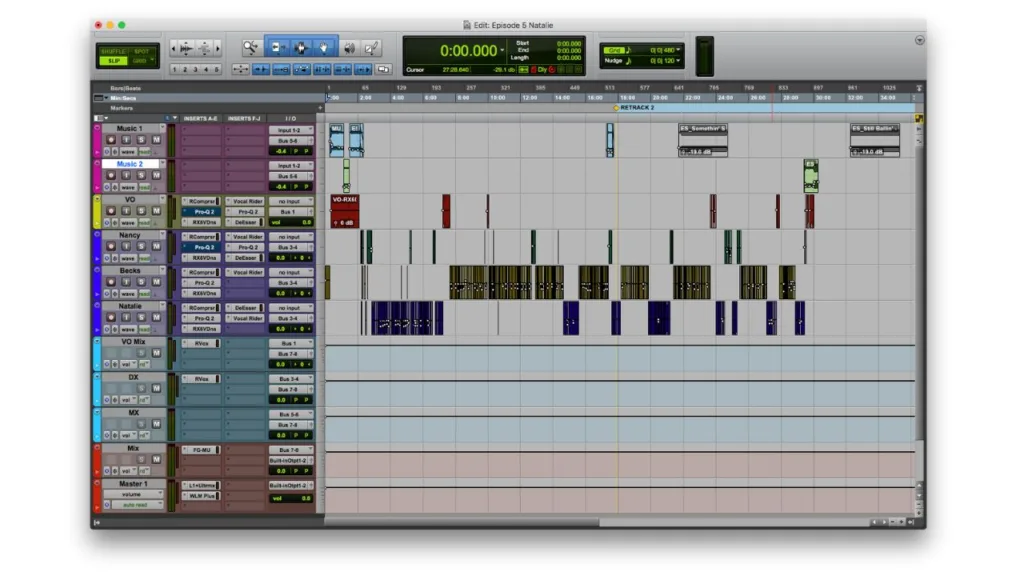
The Best DAW’s for Podcast Production
Recording Podcasts Online
Riverside
If you’ve landed on this podcast equipment guide, you already care about quality—and Riverside.fm is hands down the best way to record remote podcasts.
It’s built specifically for podcasters and content creators, delivering studio-quality audio and up to 4K video—right from your browser.
No software or app downloads needed.
Unlike Zoom, Riverside doesn’t rely on your internet connection to record clean files. It uses continuous local recording, which means your audio and video are captured directly on your device and uploaded in real time to the cloud.
If someone’s Wi-Fi cuts out or your computer crashes mid-session, your files are still safe and sound.
The result? No choppy audio. No pixelated video. Just smooth, uncompressed WAV files and crisp HD footage—ready for editing.
Riverside was built with podcasters in mind, and it shows.
Riverside.fm Features
-
Use the Magic Editor to add your logo, adjust layout, and export platform-ready videos.
-
Instantly repurpose long recordings into short social clips with Clips by Riverside.
-
Get AI-generated transcriptions, share your screen, stream live, or collaborate behind the scenes with Producer Mode.
Headphones Guide
Contrary to popular belief, you’re going to need headphones to record a podcast. I can’t tell you the number of times I’ve seen people recording podcasts without headphones. It drives me NUTS.
Why do you need headphones? Well, you need to know how you sound on the microphone, as well as how your guests sound.
Unable to hear yourself or others?
Turn up the headphone volume, and suggest everyone get closer to their mics. Hearing distortion coming from you or someone else? Turn down that microphones gain.
In addition, if you’re recording remotely and you’re hearing feedback, it could be because the guest isn’t wearing headphones, and the sound coming out of their computer speakers is getting picked up by their microphone.
It causes feedback loop. Don’t be that person. Demand that everyone in the session wear headphones.
The Best Podcast Headphones
This is a tricky one, so I wrote an article on it. The article outlines more information on the importance of wearing headphones, amnd highlights the best headphones for editing podcasts and youtube videos.
In the meantime, here are my all-time favorite headphones.
Sony MDR 7506
The Sony MDR 7506 are really high-quality headphones. They’re a staple of the TV/Film/Music/Podcast industries. These headphones are lightweight, comfortable and do a great job of rejecting background noise.
Podcast Equipment Guide: Don’t Overlook Room Acoustics
After you’ve decided on a permanent place to record in your home or office, you’ll need to do some sort of acoustic treatment. You don’t have to spend a ton of money or buy anything crazy, but, some foam for your studio will improve the sound of your recordings.
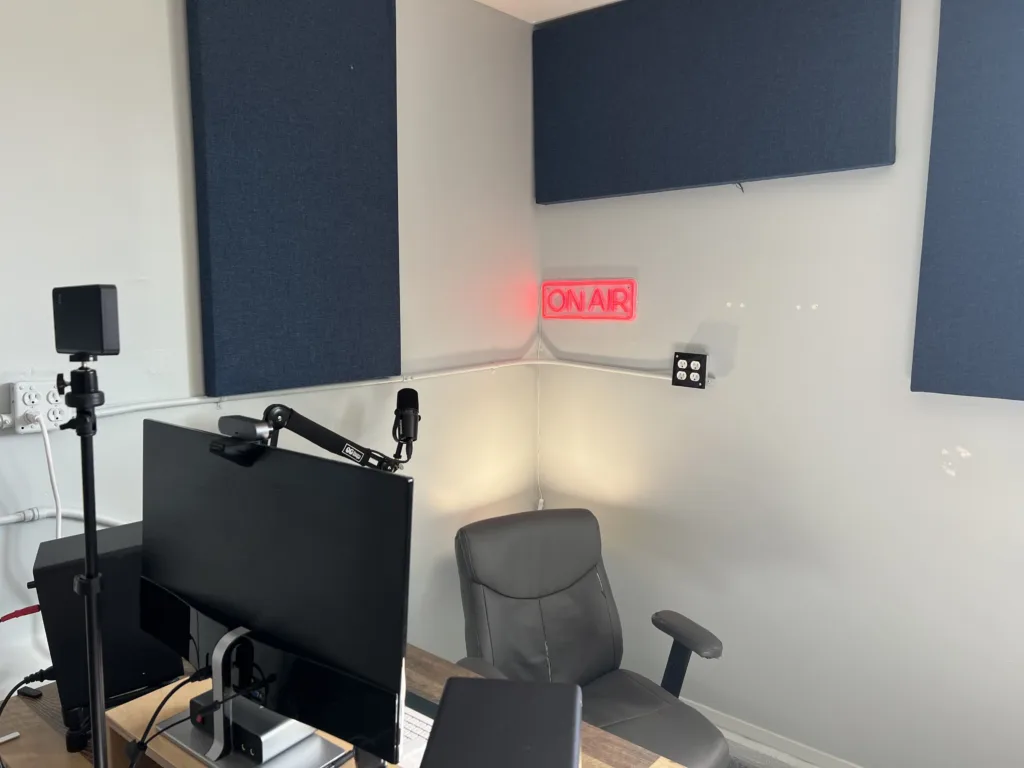
Try this, stand in the room you’re planning to podcast in. Clap a few times and listen. Do you hear the sound bouncing off the walls creating an echo effect?
This is known as slap back.
It’s the sound waves reflecting off the walls and other hard surfaces in the room.
When podcasting, the same thing is going to happen to your voice. It’s going to bounce off the walls and get picked up by your microphone. Consequently, it makes your recording sound like you’re in a bathroom or canyon.
Putting up some foam on the walls will help absorb sound waves and negate some slap back. In addition, rugs and soft furniture help with sound absorption.
To overcome this issue, put some foam panels on the walls directly to the right and left of your desk.
Next, put some on the ceiling and behind you.
The Poster Board Trick
Go to your local crafts store and buy some 2ft x 2ft poster board. Take the foam panels and glue them to the poster board.
Then, tack the poster board onto the wall. Its cleaner and beats gluing the foam directly to the wall.
It’s a bitch to pull foam directly off the wall when it’s time to move or change your set up.
Auralex Acoustic Foam
Podcast Accessories You Can’t Live Without
With so much podcast equipment to think about, podcast accessories usually fly by the wayside. However, it’s the little things that often make podcasting a little less stressful, and create a smoother workflow.
For instance, it’s best to be hands-free when recording.
This way you can look at your laptop, jot down notes, or review your episode outline. To be hands-free you need some sort of mic stand. If you’re using a USB microphone, it’s possible you will need extra USB inputs.
Podcasting into a digital recorder?
It’s a good idea to have extra SD cards for storage. A computer’s hard drive space is precious. If you’re recording onto it, it may fill up fast.
Be diligent and grab yourself an external hard drive before your main drive gets maxed out.
Recording video? Obviously you’re going to need good lighting.
The list goes on, and on.
So, to help you out, here’s a list of some great podcast accessories. I can personally endorse these because I’ve used them.
10 Favorite Podcast Accessories
- Rode PSA1 Microphone Boom Arm
- Sabrent USB 4 Port Hub
- Manfrotto Pixi Mini Tripod
- Monster Prolink XLR Cables
- Lipety 13inch Ring Light
- SanDisk SD Cards
- Lacie Harddrive
- Pop Filter
- Surge Protector
- USB C Female to USB Male
*As an Amazon Affiliate, I earn a commission if you purchase something through any of my links. This is at no additional cost to you, and helps me keep the blog alive. In addition, I’m also a Riverside.fm affiliate, and earn a commission if you use my link to sign up for their service.*
Our Podcast Equipment Guide Wrap Up
From microphones and recorders to headphones, interfaces, and room acoustics, this podcast equipment guide covers everything you need to launch or level up your show. Whatever you decide on, the gear you choose should reflect your workflow, space, and goals.
And while quality matters, simplicity and intention matter more. Use the tools that support your process—not complicate it.
Don’t overthink.
Refer back to this guide anytime you need clarity, and if you’re still unsure, try the Podcast Equipment Finder for tailored recommendations that take the guesswork out of your setup.
Go Deeper With The Podcast Haven:
Crush Your Content Goals By Reading These Articles:
- Podcast Description: How To Write a Killer Description For Your Show
- The Best Audio Interfaces For Podcasters In 2025: Complete Buyers Guide
- Best Microphone For YouTube Vlogging
- Descript: Your AI Powered Podcast & Video Studio 2025 Update
- Choosing The Best Rode Wireless Mic: Go 2 vs Wireless Pro vs Wireless Micro

